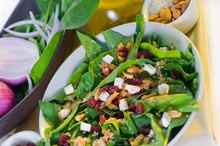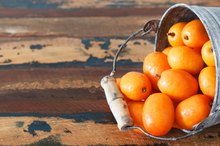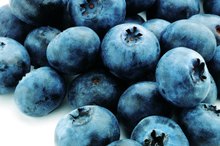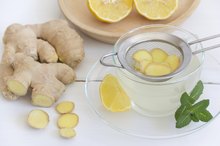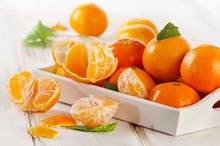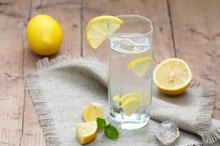What does fact checked mean?
At Healthfully, we strive to deliver objective content that is accurate and up-to-date. Our team periodically reviews articles in order to ensure content quality. The sources cited below consist of evidence from peer-reviewed journals, prominent medical organizations, academic associations, and government data.
The information contained on this site is for informational purposes only, and should not be used as a substitute for the advice of a professional health care provider. Please check with the appropriate physician regarding health questions and concerns. Although we strive to deliver accurate and up-to-date information, no guarantee to that effect is made.
What Is the Nutritional Value of Dried Cranberries Compared to Fresh Cranberries?
About 95 percent of the domestic cranberry crop -- which totaled more than 8 million barrels in 2012, according to the Agriculture Marketing Resource Center at Iowa State University -- is destined to be processed, mostly into juice 3. Although whole cranberries only make it to the average American table during Thanksgiving, both the fresh fruit and its dried counterpart are associated with significant health benefits.
Fresh Cranberries
A 1-cup serving of chopped fresh cranberries has right around 50 calories, according to the U.S. Department of Agriculture. While unprocessed cranberries aren’t a significant source of fat or protein, you’ll get just over 13 grams of carbohydrates -- an amount that includes 5 grams of fiber and about 4.5 grams of sugar -- from a cup of the chopped fruit. You’ll also get close to 15 milligrams of vitamin C, or 24 percent of the daily value based on a 2,000-calorie diet, as well as appreciable amounts of vitamins K and E.
Dried Cranberries
What Is the Percentage of Sugar in Dried Fruits?
Learn More
A cranberry’s mouth-puckering flavor intensifies as it dries, which is why most dried cranberries are made with sugar or some other kind of sweetener. A 1/3-cup serving of sweetened dried cranberries provides just over 120 calories and about 33 grams of carbohydrates, including 2.3 grams of fiber 2. Roughly 80 percent of the carbohydrates in dried cranberries come from simple sugars, according to the USDA. Because cranberries are typically sprayed with oil to keep them from sticking together as they dry, they’re slightly higher in fat than the fresh variety. They’re also devoid of vitamin C, which is destroyed by the drying process.
- A cranberry’s mouth-puckering flavor intensifies as it dries, which is why most dried cranberries are made with sugar or some other kind of sweetener.
Health Benefits
Cranberries may not pack as many vitamins and minerals into each calorie as some other fruits, but like nearly all berries, most of the health benefits associated with cranberries -- whether fresh, dried or juiced -- come from their exceptional phytochemical content. Cranberries are a top source of antioxidants, providing more free-radical-fighting substances than blueberries, blackberries, raspberries, strawberries and cherries, according to USDA analysis. They’re a significant source of proanthocyanidins, which are known to inhibit the bacteria associated with urinary tract infections, and may also interfere with the bacteria that cause stomach ulcers and gum disease.
Palatability Factor
Blueberries and Urinary Tract Infections
Learn More
Unprocessed cranberries are widely considered too tart to eat, which is why eating them generally means consuming added sugars. Even though sweetened cranberries are far more palatable, the American Heart Association notes that a diet rich in added sugars has been linked to an increased risk of dying from heart disease 4. If dried cranberries are part of your daily diet, cut back on other sources of added sugars to avoid consuming too much. Add fresh unsweetened cranberries to fruit salad -- pears, melon, grapes and other sweet fruits will help balance out their flavor and won’t count toward your intake of added sugars.
- Unprocessed cranberries are widely considered too tart to eat, which is why eating them generally means consuming added sugars.
Related Articles
References
- USDA National Nutrient Database: Cranberries, Raw
- USDA National Nutrient Database: Cranberries, Dried, Sweetened
- Agriculture Marketing Resource Center at Iowa State University: Cranberries Profile
- American Heart Association: Added Sugars Add to Your Risk of Dying from Heart Disease
- Wellness Foods A to Z: An Indispensable Guide for Health-Conscious Food Lovers; Sheldon Margen, M.D.
- Cranberries, dried, sweetened. FoodData Central. U.S. Department of Agriculture. Published April 1, 2019.
- Cranberries, dried. FoodData Central. U.S. Department of Agriculture. Published April 1, 2020
- Cranberries, raw. FoodData Central. U.S. Department of Agriculture. Published April 1, 2020
- Blumberg JB, Camesano TA, Cassidy A, et al. Cranberries and their bioactive constituents in human health. Adv Nutr. 2013;4(6):618-32. doi:10.3945/an.113.004473
- Jepson RG, Williams G, Craig JC. Cranberries for preventing urinary tract infections. Cochrane Database Syst Rev. 2012;10(10):CD001321. Published 2012 Oct 17. doi:10.1002/14651858.CD001321.pub5
- FDA Announces Qualified Health Claim for Certain Cranberry Products and Urinary Tract Infections. U.S.Food and Drug Administration. July 21, 2020
- Seyyedmajidi M, Ahmadi A, Hajiebrahimi S, et al. Addition of cranberry to proton pump inhibitor-based triple therapy for eradication. J Res Pharm Pract. 2016;5(4):248-251. doi:10.4103/2279-042X.192462
- How to Eat a Low Oxalate Diet. University of Chicago.
- Sadler MJ. Dried fruit and dental health - how strong is the evidence?. Nutr Bull. 2017;42(4):338-345. doi:10.1111/nbu.12294
Writer Bio
Based just outside Chicago, Meg Campbell has worked in the fitness industry since 1997. She’s been writing health-related articles since 2010, focusing primarily on diet and nutrition. Campbell divides her time between her hometown and Buenos Aires, Argentina.



